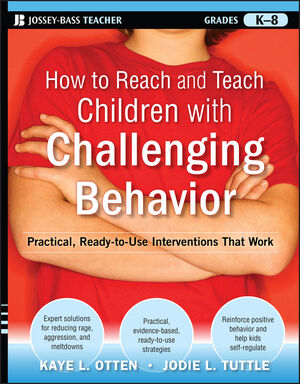How to Reach and Teach Children with Challenging Behavior (K-8): Practical, Ready-to-Use Interventions That WorkISBN: 978-0-470-50516-8
Paperback
336 pages
November 2010, Jossey-Bass
 |
||||||
About This Book vi
About the Authors vii
Acknowledgments ix
Foreword by John W. Maag xxiii
Preface xxv
PART ONE
A Positive, Proactive Approach to Behavior Management
1 A Case for Change 3
What’s Wrong with Kids Today? 4
What Happened to the Good Old Days? 4
I Didn’t Sign Up for This! 5
Students with Behavior Problems Should Just Be Suspended! 6
Punishment Works for Me! 7
What Can We Do? 8
Key Points to Remember 10
Discussion Questions 10
2 Positive Behavior Support and Functional Behavioral Assessment for Educators 12
What Exactly Is Positive Behavior Support? 13
A Three-Tiered Model 14
What Exactly Is Functional Behavioral Assessment? 15
Three Key Concepts of FBA 17
Common Functions of Problem Behavior 18
The Bottom Line on Functional Behavioral Assessment 22
Our Model of Intervention 22
Key Points to Remember 23
Discussion Questions 24
PART TWO
Social Skills Instruction
3 Teaching Social Skills: The Basics 27
Traditional Approaches to Social Skills Instruction 27
A Three-Tiered Approach to Social Skills Instruction 28
Types of Social Skills Deficits 30
Self-Management: The Ultimate Goal 33
Key Points to Remember 34
Discussion Questions and Activities 35
4 Group Social Skills Instruction 36
Schoolwide and Classwide Social Skills Instruction 36
Small Group Social Skills Instruction 43
Choosing Curricula: A Case Study 43
Key Points to Remember 46
Discussion Questions and Activities 47
5 Individualized Social Skills Instruction 57
What Behaviors Should Be Focused on During Individualized Instruction? 57
Who Should Provide Individualized Instruction? 62
When Should Individualized Instruction Take Place? 62
How Should Individualized Instruction Be Delivered? 64
Commonly Overlooked Replacement Behaviors 65
Key Points to Remember 66
Discussion Questions and Activities 66
PART THREE
Preventing Challenging Behavior
6 Preventing Challenging Behavior: The Basics 71
Targeting Setting Events and Triggering Antecedents 71
Identifying Sources of Frustration 72
Developing a Positive Relationship 73
Key Points to Remember 76
Discussion Questions 77
7 Assisting with Executive Functioning Tasks 78
Using Visual Supports 80
Assistance with Other Executive Functioning Skills 88
Key Points to Remember 93
Discussion Questions 94
8 Providing Appropriate and Engaging Academic Instruction 99
Differentiated Instruction 100
Scheduling 107
Maintaining Academic Engagement 112
Key Points to Remember 113
Discussion Questions and Activities 114
PART FOUR
Reinforcing Desired Behavior
9 Reinforcing Desired Behavior: The Basics 117
Reinforcement Versus Rewards 117
Reinforcement Versus Bribery 119
How to Determine What Is Reinforcing for Students 120
Reinforcement Menus 121
Reinforcement Schedules: Determining How Much and How Often 123
Other Issues Surrounding Reinforcement 128
Key Points to Remember 130
Discussion Questions and Activities 131
10 Group Reinforcement Systems 132
Interdependent Group-Oriented Contingencies 132
Independent Group-Oriented Contingencies 136
The Importance of Tier 1 Reinforcement 138
Key Points to Remember 138
Discussion Questions and Activities 139
11 Individual Reinforcement Systems 140
Target Behavior Sheets 140
Dependent Group-Oriented Contingency 150
Level Systems 150
Token Boards 154
Contracts 155
Key Points to Remember 160
Discussion Questions and Activities 161
PART FIVE
Using Undesirable Consequences
12 Using Undesirable Consequences: The Basics 165
Problems with Punishment 165
Natural and Logical Undesirable Consequences 167
The Three R’s of Logical Consequences 169
Punishment Versus Logical Consequences 171
Key Points to Remember 172
Discussion Questions and Activities 173
13 Common Logical Undesirable Consequences 174
Common Undesirable Consequences Continuum 175
The Importance of Problem Solving 178
Consequence Maps 179
Alternatives to Out-of-School Suspension 181
Key Points to Remember 188
Discussion Questions and Activities 189
PART SIX
Putting It All Together
14 Conducting Effective and Efficient Functional Behavioral
Assessments 193
Step One: Operationally Define the Problem and Replacement Behaviors 195
Step Two: Collect Information 195
Step Three: Develop Hypotheses About Why the Problem Behavior
Is Occurring 199
Key Points to Remember 202
Discussion Questions and Activities 203
15 Designing and Implementing Effective and Efficient Behavior Intervention Plans 204
Step 4: Design a Behavior Intervention Plan Based on the Functional
Behavioral Assessment 204
Step Five: Monitor and Adjust the Behavior Intervention Plan as Needed 205
Key Points to Remember 209
Discussion Question 209
16 Example Success Stories 210
Example 1: Joey 211
Example 2: Susan 218
Example 3: Taylor 228
Example 4: Malik 237
PART SEVEN
What About Dangerous Behavior? Managing Crises
17 Intervening During the Escalation Cycle 247
Stage One 248
Stage Two 248
Stage Three 249
Stage Four 250
Stage Five 250
Stage Six 251
Key Points to Remember 253
Discussion Questions and Activities 254
18 Physical Restraint and Seclusion 255
Definitions 256
Historical Overview 256
Roots of the Problem 257
Current School Culture 257
What Can Educators Do? 260
Key Points to Remember 262
Discussion Questions and Activities 265
PART EIGHT
Reproducible Tools
1 Positive-to-Negative Ratio Data Sheet 268
2 Break Pass 269
3 Countdown Strips 270
4 Chart Moves Frame 271
5 Peer Comparison Direct Observation Form 272
6 Consequence Map Template 273
7 If-Then Chart Template 274
8 Notes Template for Functional Behavioral Assessment 275
9 Functional Behavioral Assessment Summary Worksheet 276
10 Behavior Intervention Plan Worksheet 278
Glossary 281
Notes 287
References 293
Index 299



